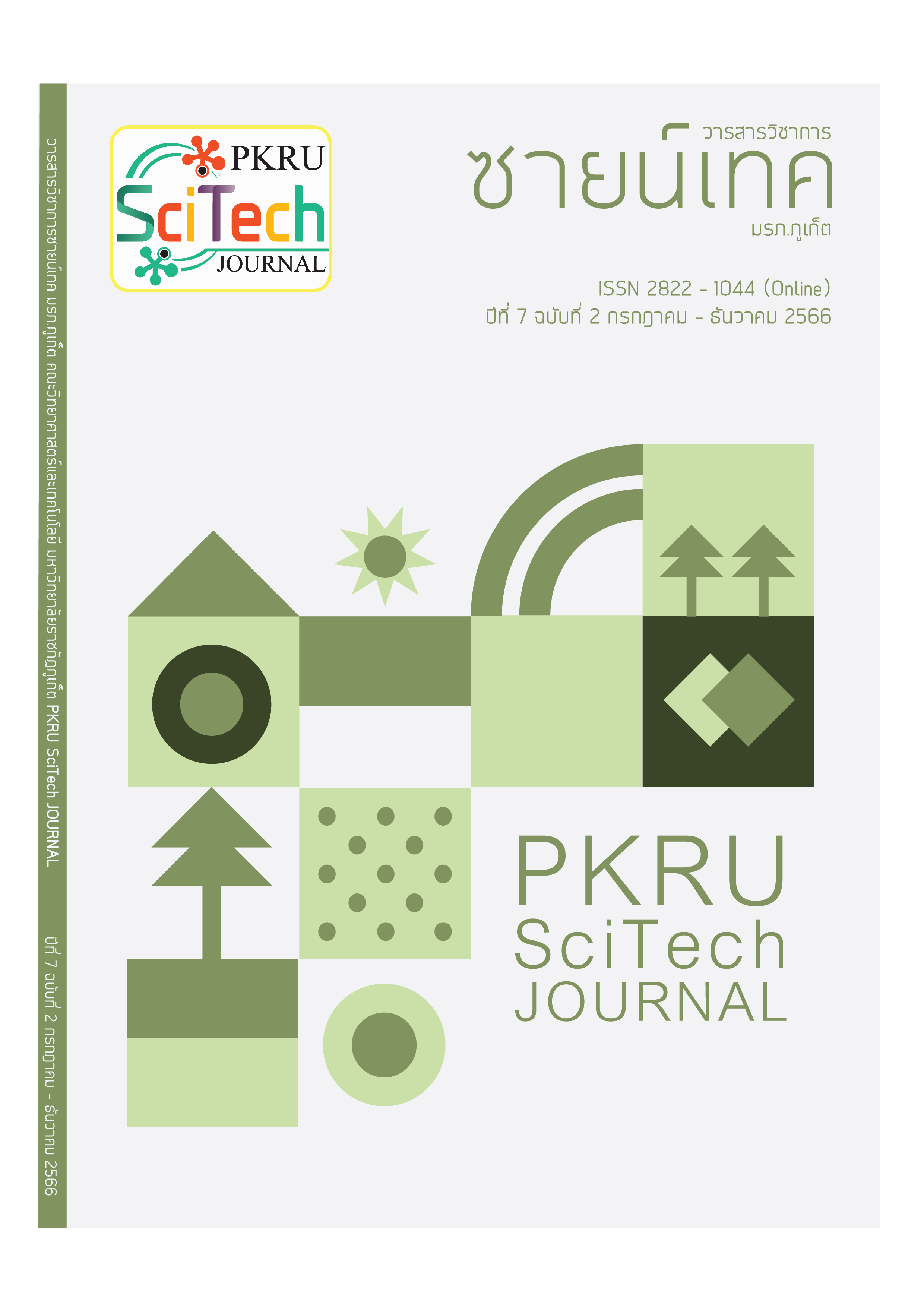ปริมาณฟีนอลและฟลาโวนอยด์รวม และฤทธิ์ต้านอนุมูลอิสระจากใบหว้าหิน
Main Article Content
บทคัดย่อ
งานวิจัยนี้มีวัตถุประสงค์เพื่อศึกษาปริมาณฟีนอลรวม ปริมาณฟลาโวนอยด์รวม และฤทธิ์ต้านอนุมูลอิสระของสารสกัดหยาบเอทานอลรวมทั้งส่วนแยกย่อย (CS-A ถึง CS-O) จากใบหว้าหิน ผลการวิจัยพบว่าปริมาณฟีนอลรวมของส่วนแยกย่อย CS-M มีปริมาณฟีนอลรวมมาก (568.08 ± 9.38 มิลลิกรัมสมมูลของกรดแกลลิกต่อกรัมของสารสกัด) และส่วนแยกย่อย CS-C มีปริมาณสารฟลาโวนอยด์รวมมากที่สุด (139.85 ± 12.52 มิลลิกรัม สมมูลของเควอซิทินต่อกรัมของสารสกัด) ผลฤทธิ์ต้านอนุมูลอิสระด้วยวิธี DPPH พบว่าสกัดหยาบ CS และส่วนแยกย่อย CS-O มีค่า IC50 เท่ากับ 2.16 ± 0.01และ 1.76 ± 0.01ไมโครกรัมต่อมิลลิลิตร ตามลำดับ (IC50 ของสารมาตรฐาน เท่ากับ 3.79 ± 0.06 ไมโครกรัมต่อมิลลิลิตร) ผลที่ได้แสดงให้เห็นศักยภาพของสารสกัดและบางส่วนแยกย่อยจากใบหว้าหินมีปริมาณฟีนอลและฟลาโวนอยด์รวมที่สูงและมีฤทธิ์ต้านอนุมูลอิสระที่ดี เหมาะสำหรับการพัฒนาเป็นผลิตภัณฑ์ส่งเสริมสุขภาพและเวชสำอางในอนาคต
Article Details

This work is licensed under a Creative Commons Attribution-NonCommercial-NoDerivatives 4.0 International License.
- เนื้อหาต้นฉบับที่ปรากฏในวารสารเป็นความรับผิดชอบของผู้เขียน ทั้งนี้ไม่รวมความผิดพลาดอันเกิดจากเทคนิคการพิมพ์
- ลิขสิทธิ์ต้นฉบับที่ได้รับการตีพิมพ์ในวารสารวิชาการ ซายน์เทค มรภ.ภูเก็ต ถือเป็นกรรมสิทธิ์ของวารสารวิชาการ ซายน์เทค มรภ.ภูเก็ต
References
Fang, Y. Z., Yang. S., & Wu, G. (2002). Free radical, antioxidant, and nutrition. Nutrition, 18, 872-879.
Valko, M., Leibfritz, D., Moncol, J., Cronin, M. T. D., Mazur, M., & Telser, J. (2007). Free radicals and antioxidants in normal physiological functions and human disease. Int J Biochem Cell Biol, 39, 44-84.
Cornish, M. L., & Garbary, D. J. (2010). Antioxidant from microalgae: potential application in human health and nutrition. Free Radical Biology & Medicine, 25, 155-171.
Halliwell, B., & Gutteridge, J. M. C. (1999). Free radicals in biology and medicine, 3rd Edition, Oxford University Press, Oxford, 1-25.
Chaithada, P., Supapan, J., Rodthuk, P., & Chainarong, S. (2018). Total flavonoids, total phenolic content and antioxidant activity from fruits, leaves, twigs and flowers of Mesua ferrea L. Walailak Journal of Science and Technology, 15(4), 295-304.
Shafi, P. M., Rosamma, M. K., Jamil, K., & Reddy, P. S. (2002). Antioxidant and antibacterial activities of crude extracts and essential oils of Syzygium cumini leaves. Fitoterapia, 73, 414-416.
Ravi, K., Ramachandran, B., & Subramanian, S. (2004). Protective effect of Eugenia jambolana seed kernel on tissue antioxidants in streptozotocin induced diabetic rats. Biol Pharm Bull, 27, 1212–1217.
Bajpai, M., Pande, A., Tewari, S. K., & Prakash, D. (2005). Phenolic contents and antioxidant activity of some food and medicinal plants. Int J Food Sci Nutr, 56, 287–291.
Benherlal, P. S., & Arumughan, C. (2007). Chemical composition and in vitro antioxidant studies on Syzygium cumini fruit. J Sci Food Agric, 87, 2560–2569.
Fujioka, T., Kashiwada, Y., Kilkuskie, R. E., Cosentino, L. M., Ballas, L. M., Jiang, J. B., Janzen, W. P., Chen, I. S., & Lee, K. H. (1994). Anti-AIDS agents, 11. Betulinic acid and platanic acid as anti-HIV principles from Syzigium claviflorum, and the anti-HIV activity of structurally related triterpenoids. J Nat Prod, 57(2), 243-247.
Shilpa, K. J., Krishnakumar, G., & Sooryaprakash, S. (2014). Phytochemical composition, antioxidant, and antibacterial activities of two Syzygium spp. Journal of Herbs, Spices & Medicinal Plants, 20, 45–54.
Singleton, V. L., & Rossi, J. (1965). Colorimetry of total phenolics with phosphomo-lybdicphos-phortungstic acid reagents. American Journal of Enology and Viticulture, 16, 144-158.
Biju, J., Sulaiman, C. T., Satheesh, G., & Reddy, V. R. K. (2014). Total phenolics and flavonoids in selected medicinal plants from kerala. International Journal of Pharmacy and Pharmaceutical Sciences, 6(1), 406-408.
Blois, M. S. (1958). Antioxidant determinations by the use of a stable free radical. Nature, 4617, 1199-1200.
Evans, J. D. (1996). Straightforward statistics for the behavioral sciences.USA: Brooks/Cole Publishing.
Ngamdee, P., Wichai, U., & Jiamyangyuen, S. (2016). Correlation between phyto-chemical and mineral contents and antioxidant activity of black glutinous rice bran, and its potential chemopreventive property. Food Technol Biotechnol, 54(3), 282–289.
Souri, E., Amin, G., Farsam, H., & Barazandeh T.M. (2008). Screening of antioxidant activity and phenolic content of 24 medicinal plant extracts. DARU Journal of Pharmaceutical Sciences, 16(2), 83-87.
Koodkaew, I., & Limpichotikul, P. (2017). Study of antioxidant activity and correlation of antioxidant compounds in eight species of garden herbs. Journal of Food Health and Bioenvironmental Science, 10, 137-152.
Thepthong, P., Boontaworn, B., & Saewan, N. (2022). Total phenolics, antioxidant, anti-tyrosinase, anti-collagenase and cell proliferation activities of Chrysophyllum cainito green fruit extract. PKRU SciTech Journal, 6(1), 24-33.
Hajimahmoodi, M., Mohammadi, N., & Soltani, N. (2010). Evaluation of antioxidant properties and total phenolic contents of some strains of microalgae. J Appl Phycol, 22(1), 43–50.
Ruberto, G., & Baratta, M. T. (2000) Antioxidant activity of selected essential oil components in two lipid model systems, Food Chem, 69, 167–174.
Chaisri, P., & Laoprom, N. (2016). Antioxidant properties and total phenolic content of selected traditional thai medicinal plants. Thai Pharmaceutical and Health Science Journal, 12(1), 10-18.
Ahmed, S., Jubair, A., Hossain, M. A., Hossain, M. M., Azam, M. S., & Biswas, M. (2021). Free radical-scavenging capacity and HPLC-DAD screening of phenolic compounds from pulp and seed of Syzygium claviflorum fruit. Journal of Agriculture and Food Research, 6, 100203.

